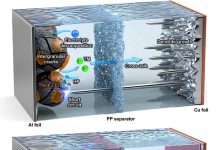
A team of scientists in South Korea has developed a new perovskite solar cell that not only delivers record-breaking efficiency but also lasts more than three times longer than conventional versions.
The breakthrough could help bring this promising solar technology closer to widespread use in real-world energy systems.
The research, published in Nature Energy, was led by Professors Changduk Yang and Seung-Jae Shin from the School of Energy and Chemical Engineering at UNIST, in collaboration with Professor Hanul Min from Korea University.
Their team achieved a certified power conversion efficiency of 25.8% (with a peak lab result of 26.2%) while solving one of perovskite solar cells’ biggest problems—poor long-term stability.
Perovskite solar cells have attracted tremendous attention over the past decade because they are inexpensive to produce and can reach very high efficiencies.
However, they tend to degrade quickly, especially in heat or humidity. One major reason for this instability lies in a small but crucial ingredient: liquid additives used to improve the movement of electric charges inside the cell.
Most perovskite cells use 4-tert-butylpyridine (tBP), a liquid additive that helps boost performance but evaporates easily under high temperatures.
As it evaporates, it leaves behind tiny holes and unwanted byproducts that cause the solar cell to lose efficiency and break down over time.
To overcome this issue, the UNIST-Korea University team developed a solid additive called 4-(N-carbazolyl)pyridine (4CP). Unlike tBP, the new 4CP compound doesn’t evaporate, meaning it maintains its structure and performance even under harsh conditions.
It also helps form smoother, more uniform layers inside the solar cell, improving charge transfer and reducing the microscopic defects that typically shorten a device’s lifespan.
The results were dramatic. Solar cells using the new 4CP additive retained 80% of their initial efficiency after 3,000 hours of continuous operation—equivalent to more than four months of nonstop use.
They also proved highly durable under extreme environments, maintaining over 90% efficiency after 200 thermal shock cycles between -80°C and 80°C.
Even when heated continuously at 85°C for hundreds of hours, the 4CP-based cells kept most of their performance, while conventional designs lost more than half within a few days.
“This study shows that simply switching to a stable solid additive can greatly extend the lifespan of perovskite solar cells without changing the manufacturing process,” the researchers said.
Because the new additive works with existing production methods, it could be easily adopted by manufacturers, paving the way for commercial-scale solar panels and even space-grade perovskite devices.
The team now plans to scale up the technology into larger modules to test its real-world potential, bringing the dream of long-lasting, affordable solar power one step closer to reality.
Source: KSR.



